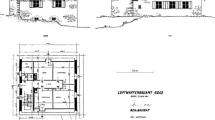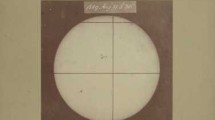Abstract
Sunspot numbers are important tracers of historical solar activity. They are important in predicting the oncoming solar maximum, in the design of lifetimes of space assets, and in assessing the extent of solar-radiation impact on the space environment. Historically, sunspot numbers have been obtained visually from sunspot drawings. The availability of digital images from the US Air Force Improved Solar Optical Observing Network (ISOON) prototype telescope concurrent to observer-dependent sunspot numbers recorded at the National Solar Observatory (NSO) has provided a basis for comparing sunspot numbers determined from the two methods. We compare sunspot numbers from visual and digital methods observed nearly simultaneously. The advantages of digital imagery are illustrated.










Similar content being viewed by others
References
Allen, C.W.: 1991, Astrophysical Quantities, Athlone Press, London.
Balasubramaniam, K.S.: 2002, Astrophys. J. 575, 553.
Balasubramaniam, K.S., Pevtsov, A.A.: 2011, In: Solar Physics and Space Weather Instrumentation, Proc. SPIE 8148.
Cliver, E.W., Clette, F., Svalgaard, L.F.: 2013, Cent. Eur. Astrophys. Bull. 37, 401.
Györi, L., Baranyi, T., Ludmány, A.: 2010, In: Choudhary, D.P., Strassmeier, K.G. (eds.) The Physics of Sun and Star Spots Proc. IAU Symp. 273, Cambridge University Press, Cambridge, 403. ADS . DOI .
Hathaway, D.H.: 2010, Living Rev. Solar Phys. 12, 4. DOI .
Hathaway, D.H., Wilson, R.M., Reichman, E.J.: 1999, J. Geophys. Res. 104, 22375.
Henry, T.W.: 2015, Solar ephemeris applications and image analysis. MS thesis, Texas Tech University, Lubbock, TX.
Hoyt, D.V., Schatten, K.H.: 1998, Solar Phys. 179, 189. ADS . DOI .
Hoyt, D.V., Schatten, K.H., Nesme-Ribes, E.: 1994, Geophys. Res. Lett. 21(18), 2067.
Neidig, F., Henry, T.: 2004, Comparing sunspot numbers between NSO and ISOON: NSO/Sac peak projection board drawings vs. ISOON semi-automatic procedure. NSO Internal Technical Document (private communication).
Neidig, D., Wiborg, P., Confer, M., Haas, B., Dunn, R., Balasubramaniam, K.S., Gullixson, C., Craig, D., Kaufman, M., Hull, W., McGraw, R., Henry, T., Rentschler, R., Keller, C., Jones, H., Coulter, R., Gregory, S., Schimming, R., Smaga, B.: 1998, In: Balasubramaniam, K.S., Harvey, J., Rabin, D. (eds.) Synoptic Solar Physics CS-140, Astron. Soc. Pac., San Francisco, 519.
Pötzi, W., Veronig, A.M., Temmer, M., Baumgartner, D., Freislich, H., Strutzmann, H.: 2016, Solar Phys. DOI .
Sivaraman, K.R., Gupta, S.S., Howard, R.F.: 1993, Solar Phys. 146, 27. ADS . DOI .
Smith, H.J., Smith, E.P.: 1963, Solar Flares, Macmillan Co., New York.
Tlatov, A.G., Vasil’eva, V.V., Markova, V.V., Otkidychev, P.A.: 2014, Solar Phys. 289, 1403. ADS . DOI .
Acknowledgments
This work was supported by the Space Vehicles Directorate, Air Force Research Laboratories (AFRL) and The Air Force Office of Scientific Research; AFRL. We are grateful to Donald Neidig and numerous members of joint AFRL–NSO ISOON Team, the AFRL Space Vehicles Directorate, and the NSO for developing and operating the ISOON prototype telescope for a decade and preserving its data. Particularly, Neidig’s insights into calibration of the data and into sunspot-counting techniques have inspired this article. We thank Ed Cliver, Frédéric Clette, Leif Svalgaard, and numerous colleagues for sustaining the important sunspot-number research through these workshops.
Author information
Authors and Affiliations
Corresponding author
Ethics declarations
Disclosure of Potential Conflicts of Interest
The authors declare that they have no conflicts of interest.
Additional information
Sunspot Number Recalibration
Guest Editors: F. Clette, E.W. Cliver, L. Lefèvre, J.M. Vaquero, and L. Svalgaard
Rights and permissions
About this article
Cite this article
Balasubramaniam, K.S., Henry, T.W. Sunspot Numbers from ISOON: A Ten-Year Data Analysis. Sol Phys 291, 3123–3138 (2016). https://doi.org/10.1007/s11207-016-0874-5
Received:
Accepted:
Published:
Issue Date:
DOI: https://doi.org/10.1007/s11207-016-0874-5




